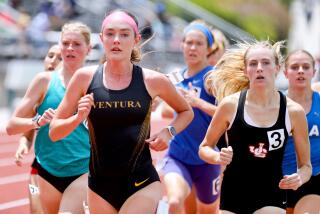700 Science Entries Vie for Top Honors : Education: Projects ranging from cooling the heat of chili peppers to family personality differences compete for awards in Ventura County contest.
- Share via
Nicholas Guzman’s idea for his science project began as a burning sensation.
“When I was eating chile peppers,” the 17-year-old Fillmore High School student said, “it got too hot.”
After he grabbed the nearest drink he could find to cool his mouth, Nicholas began to wonder which beverages work best to provide relief to people who like their food hot.
He decided to investigate.
The resulting science project, titled “Red Hot Chile Peppers,” is one of 700 entries in the 1994 Ventura County Science Fair being held this week at the County Fairgrounds in Ventura.
Students in the sixth through eighth grades from private and public schools throughout the county entered projects in categories ranging from psychology to chemistry to math.
And Wednesday, 80 local scientists, teachers and other professionals spent hours evaluating the entries and interviewing students to select the fair’s winners, who will be announced today.
In addition to looking for originality among the science projects, judges said they also rate projects according to how well students frame the question they are trying to answer and what experimental techniques they follow.
“Mostly we look for how well the scientific method is applied,” said judge Raquel Izumi, a research associate at Amgen in Thousand Oaks.
For Nicholas’ project on chile peppers, he conducted taste tests on 20 family members, friends and acquaintances.
After blindfolding each of his subjects, Nicholas fed them a type of hot chile pepper called chile de arbole and, after each pepper, had the subjects drink sodas, juice, milk and other liquids. The subjects told Nicholas how well each drink worked on cooling their burning mouths.
But the experiment’s results were clear: The best beverage to drink after chomping on a hot pepper is milk.
Like Nicholas’ project, many entries at this year’s science fair attempted to find solutions to real-life problems. And some judges said one of their main criteria was for projects to have practical value.
Encouraging students to focus on science projects with a practical application helps prepare them for the world of work, judge Danny Clark said.
“When you’re actually working, you have to have some real-life application or you’re not going to get paid,” said Clark, an electronics engineer at the Port Hueneme Naval Surface Warfare Center. “You can’t just divide numbers for the fun of it.”
As an example of a project with practical value, some judges cited a psychology experiment--titled “Are Personalities Hereditary?”--by Thousand Oaks student Rachel Garfield.
A sophomore at private La Reina High School, Rachel said she got the idea for her project after an argument with her mother.
“I’d just been in a fight with my mother and I wanted to know why we couldn’t get along,” the 15-year-old said.
Assuming that she and her mother fought because they are different, Rachel tested this hunch by taking a psychological personality test she had at her home and then giving the test to her mother.
To her surprise, they both had the same personality types.
Then Rachel began to wonder whether personality was hereditary. So she gave the same psychological test to the parents and children in 26 families--half of whom had adopted children.
Her results showed that biological children nearly always have personalities similar to one of their parents, while adopted children only rarely have temperaments like their mothers and fathers.
More to Read
Sign up for Essential California
The most important California stories and recommendations in your inbox every morning.
You may occasionally receive promotional content from the Los Angeles Times.












